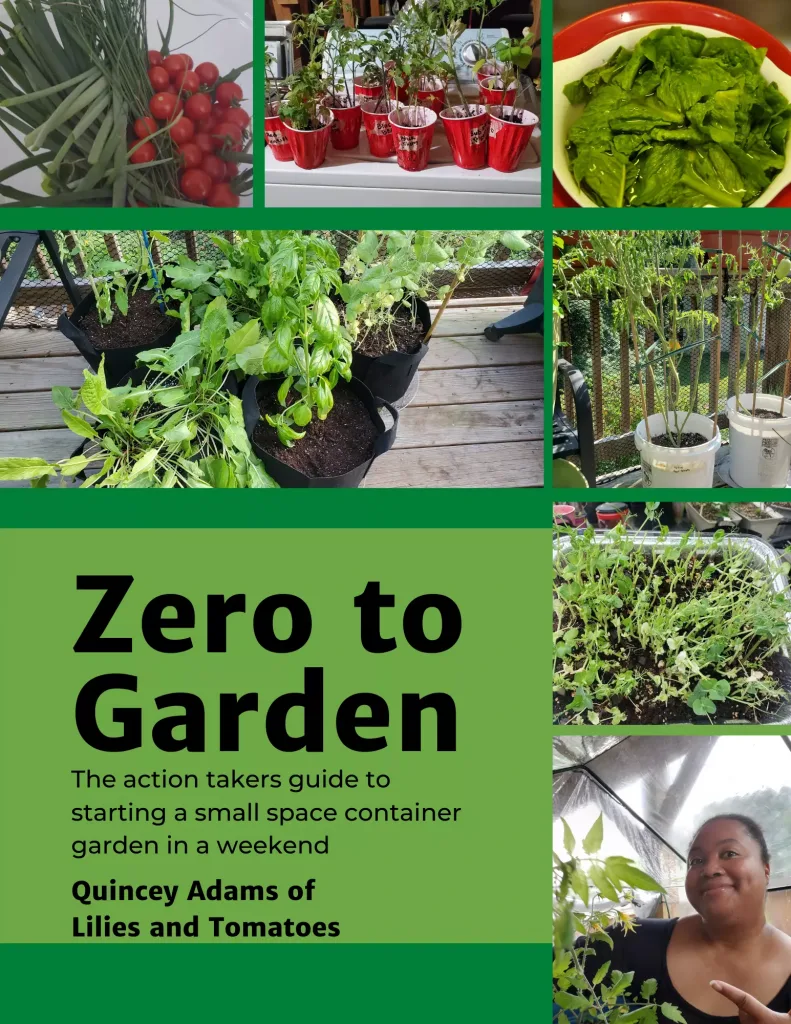Do you want to grow your own food at home?
You’re not alone. Many people are interested in growing their own food but don’t know where to start. I’m here to help with that!
This is the resource page for the book that will be your go-to manual for everything you need to get started, from where to get plants, soil, and containers, to how much they cost. It also includes how to plant your containers and how to keep your plants alive.
This page has additional information that you may find useful as you read the book. You can buy a copy of the book on Amazon using this link https://amzn.to/3GvWpVv.
“As an Amazon Associate I earn from qualifying purchases.”
This book is based on my experience as a container gardener. I have lived mostly in apartments with a balcony. Small spaces.
I try to get things done most practically and efficiently. I am not an organic gardener. But I do limit the use of pesticides.
The recommendations that I make are to help you get growing as fast as possible.
This is your one-stop for all of the videos linked in the ebook or mentioned in the book if you bought it in paperback.

Links from the book
Table of Contents
Where to find me
Chapter 2: The garden
This garden is what I call a 5 by 5 garden. Five containers that hold 5 gallons of soil each. This size is good enough to grow a lot of common fruits and vegetables.
This garden will be big enough to grow enough food to supplement a few meals a week and be worth the effort to go buy the materials. It is small enough that it will only take a few minutes per day to maintain.
If you would like to see my gardening class on setting up a 5 by 5 garden, you can check it out on my website.
Chapter 3: Where do you get the containers
You can buy a set of fabric grow bags on Amazon for about $20. These are usually more expensive at garden centers.
If you decide to go with buckets, you can buy them for about $5 each at a hardware store.
You can also ask at the bakery section of a grocery store or some fast food places if they will give you or sell you the plastic buckets that food comes in. You will need to drill drainage holes in these.
Make sure that the buckets are safe to grow food in. A number on the bottom will tell you what kind of plastic the bucket is made out of. Buckets with a 1, 2, 4, or 5 are considered safe for growing in. The number 2 is the best.
If you would like to see my gardening class on Plastic that is safe to grow in, you can check it out on my Youtube Channel.
Chapter 3: Where do you get the containers
You can also check on the Facebook marketplace or Craigslist for used containers. You can find good deals but you have to search for a while.
Another budget-friendly option is plastic storage bins. You may already own some of these. You can find large bins at discount stores or dollar stores. You will have to add drainage holes to these.
If you would like to see my gardening class on turning a dollar store basket into a container, you can check it out on my Youtube Channel.
Further information
How to make a container out of something else you may have at your house.
Choosing plants for your 5 by 5 garden
Before you buy anything, I want you to think about what you want to grow, why you want to grow it, and where you will put your garden.
Let’s start by thinking about what you want to accomplish with your garden.
Chapter 3: What plants should you buy
For this garden, I recommend that you buy plant starts from a garden center or big box store. They are called plant starts because that’s what they give you, a head start with your garden. Plant starts will save you six to eight weeks of time.
Starting your garden from seed is much cheaper but it will take a lot longer to get a harvest. If you have the budget for seeds in addition to plants, get some for your next garden three months from now. You can find cheap seeds at a dollar store.
If you would like to see my gardening class on seed starting, you can check it out on my website.
Chapter 3: What plants should you buy
If you want to save money on plants check Facebook Marketplace for home growers selling excess plants or try kitchen scrap gardening.
If you would like to see my gardening class on kitchen scrap gardening, you can check it out on my website.
Further information
Second Kitchen Scrap Gardening Lesson
Third Kitchen Scrap Gardening Lesson
Chapter 3: Fertilizer and soil amendments
The easy and cost-efficient way to buy fertilizer for a small garden is to buy a balanced fertilizer. The fertilizer will be labeled with an NPK value.
The N stands for nitrogen, this helps the plant develop leaves. The P stands for phosphorus, this helps your plants develop fruit and flowers. The K stands for potassium, this helps with overall plant health.
In a balanced fertilizer the N, P, and K values will all be the same. The label will say 5-5-5 or 10-10-10. The number can be higher or lower but a balanced fertilizer is cost-effective and will get you off to a good start.
If you would like to see my gardening class on NPK, you can check it out on my website.
Chapter 3: There will be bugs
It doesn’t matter if you set up your garden inside or outside, eventually, there will be bugs. That is just the nature of gardening.
If your plants have a more serious pest problem you may want to consider some kind of insecticide. Insecticides, like the soil and fertilizer, can be organic or traditional.
If you decide to buy insecticide, make sure you follow the directions and get the correct insecticide for the type of pests that you have.
For a potentially cheaper option, you can make your own insecticidal soap. If you already have the ingredients, it’s cheaper. If you don’t have the ingredients it isn’t cheaper.
If you would like to see my gardening class on making insecticidal soap, you can check it out on my website.
Chapter 4: How to plant your container garden
Planting a container garden is simple. If you are doing this inside you may want to put down a plastic garbage bag or a sheet to collect dirt that falls on the floor.
- Fill your containers with soil, up to the top but not overflowing.
- Use your hand trowel to create an indent in the soil. The indent should be as deep as the container your plant start came in.
- Remove the plant start from the container that it came in by turning it upside down while you hold it in place with your fingers.
- Turn the plant right side up and set it in the indent that you made in the soil of your container.
- Pack the mounded soil down around the plant start firmly but not so hard that you damage the roots of the plant.
If you would like to see my gardening class on Planting a tomato seedling, you can check it out on my website.
How to keep your plants alive
Check on your plants every day. If your plants are outside in direct sun they can suffer irreparable damage in just a couple of days from excessive heat, lack of water, or pest infestation.
What do you need to check? Check your soil moisture, inspect your plants for damage or pests, and harvest the fruit if it’s ready.
Chapter 4: Plant Pests
If the leaves have visible holes then there is a good chance that whatever is eating your plant is big enough to get picked off.
Some pests are really good at camouflage. You may see signs that they have been there but not the actual bugs.
If you can see something moving on your leaves but the pests are too small to pick off, try wiping them off with a damp cloth or picking them off with a piece of tape.
Cabbage worms and cutworms are exceptions because a few of them can quickly destroy an entire plant.
If you would like to see my gardening class on how I get rid of cabbage worms, you can check it out on my Youtube Channel.
Chapter 4: What if my plant dies?
Are you sure it’s dead? I’m not trying to be funny. If your plant has had time for root development but doesn’t look alive, try the pull test before you trash it.
What is the pull test? It’s when you give the plant a firm tug at the stem to see if the roots hold onto the soil. A firm tug does not mean all of your might.
If the plant comes out of the soil, it’s dead. If it holds on, give it a little fertilizer and wait. It may recover.
If you would like to see my gardening class on the pull test, you can check it out on my website.
Further Information
A caveat to the pull test.
Chapter 4: Bonus garden
If you read through this whole book but are still too nervous or too busy to start a 5 by 5 garden, I have a challenge for you.
Grow some pea shoots.
If you would like to see my gardening class on pea shoots, you can check it out on my website.
Using the Worksheets
The Beginner Garden Worksheet and the Fall Garden Guide will help you collect the information you need for your garden and plant a fall garden. One of the ways that you will get the most out of your 5 by 5 garden is to grow for at least 3 seasons if not 4.
Need to buy a copy of the book? Click here to go to the Zero to Garden Sales Page.


